Niacin, or Vitamin B3, is an essential nutrient vital for over 400 enzyme functions, playing a critical role in energy production, DNA repair, and overall metabolic health. While typically known for its benefits in lipid management at therapeutic doses, its use as a pre-exercise supplement—often found in "pre-workout" blends—presents a metabolic paradox for athletes, particularly those focused on endurance or fat adaptation.
At the core of this complexity is niacin’s potent, acute anti-lipolytic effect.
The Mechanism: Niacin and HSL Inhibition
When consumed in high doses (far exceeding the Recommended Daily Allowance), niacin acts to significantly lower the level of circulating free fatty acids (FFAs) in the bloodstream. It achieves this primarily by binding to a receptor on fat cells (adipocytes) which, through a signaling cascade, inhibits the key fat-burning enzyme: Hormone-Sensitive Lipase (HSL).
HSL is critical for breaking down stored body fat (triacylglycerols) into FFAs and glycerol, which are then released into the blood to be used as fuel. By inhibiting HSL, high-dose niacin effectively puts a temporary brake on the body's ability to mobilize fat stores for energy.
Impact on Athletic Performance and Fat Burning
For an athlete, particularly in endurance sports like long-distance running or cycling, the body relies heavily on fat oxidation to spare limited glycogen stores. This is where the anti-lipolytic effect of high-dose niacin can be detrimental:
-
Impaired Fuel Availability: By limiting the availability of FFAs—a preferred fuel source during prolonged, moderate-intensity exercise—the body is forced to rely more heavily on its carbohydrate (glycogen) reserves.
-
Reduced Time to Exhaustion: Studies involving acute high-dose niacin ingestion before exercise have shown an increase in the Respiratory Exchange Ratio (RER). A higher RER indicates a greater reliance on carbohydrate fuel and a decreased rate of fat oxidation. This premature shift can lead to faster depletion of muscle glycogen, resulting in decreased time to exhaustion and impaired aerobic performance.
-
Blunted Recovery: Research also suggests that the temporary suppression of fat mobilization may reduce the magnitude of the Excess Post-exercise Oxygen Consumption (EPOC), the "afterburn" effect that contributes to overall calorie expenditure post-exercise.
Key Takeaway: For athletes and individuals aiming to maximize fat oxidation during exercise—a common goal for endurance training or body composition improvement—acute ingestion of high-dose niacin supplements is contraindicated due to its mechanism of HSL inhibition and the resulting restriction on fat fuel availability.
Distinction: Supplement vs. Dietary Intake
It is crucial to distinguish between pharmacological doses of niacin (typically 500 mg and above) used for therapeutic purposes and the intake from a balanced diet.
Dietary niacin is a critical component of healthy energy metabolism and should not be avoided. The issue is with the supraphysiological doses found in some pre-workout products or used in cholesterol-lowering regimens, which trigger the powerful anti-lipolytic response.
In summary, while niacin is an essential B-vitamin, its use as a high-dose supplement immediately prior to training fundamentally works against the metabolic goals of maximizing fat utilization during exercise. Athletes should prioritize a diet sufficient in B-vitamins while being cautious of high-dose niacin supplementation in the context of performance enhancement.

